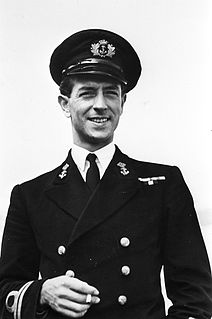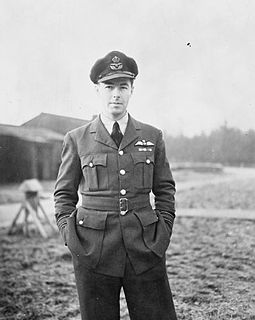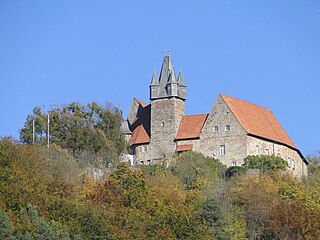
Castle Colditz is a Renaissance castle in the town of Colditz near Leipzig, Dresden and Chemnitz in the state of Saxony in Germany. The castle is between the towns of Hartha and Grimma on a hill spur over the river Zwickauer Mulde, a tributary of the River Elbe. It had the first wildlife park in Germany when, during 1523, the castle park was converted into one of the largest menageries in Europe. The castle gained international infamy as the site of Oflag IV-C, a prisoner-of-war camp during World War II for "incorrigible" Allied officers who had repeatedly attempted to escape from other camps.

Büsingen am Hochrhein, commonly known as Büsingen, is a German municipality (7.62 km2 [2.94 sq mi]) in the south of Baden-Württemberg and an enclave entirely surrounded by territory belonging to Switzerland. It has a population of about 1,450 inhabitants. Since the early 19th century, the village has been separated from the rest of Germany by a narrow strip of land containing the Swiss village of Dörflingen.

Etienne Henri "Hans" Larive, MWO, DSC and bar, was a Dutch naval officer during World War II. He escaped from the prisoner of war camp Oflag IV-C at Colditz Castle in 1941, and spent the rest of the war in England serving aboard Motor Torpedo Boats. He later wrote his memoir Vannacht varen de Hollanders (1950), which was republished translated into English as The Man Who Came in From Colditz (1975) – a pun on the best-selling novel The Spy Who Came in from the Cold.

The Colditz Story is a 1955 British prisoner of war film starring John Mills and Eric Portman and directed by Guy Hamilton. It is based on the book written by Pat Reid, a British army officer who was imprisoned in Oflag IV-C, Colditz Castle, in Germany during the Second World War and who was the Escape Officer for British POWs within the castle.
Lieutenant Albert Michael Sinclair, DSO, known as the Red Fox, was a British prisoner at Colditz Castle during World War II. He was involved in a number of escape attempts and was recognised within the camp for his determination to escape. Sinclair was the only person to be killed while attempting to escape Colditz.
Patrick Robert Reid, was a British Army officer and author of historical non-fiction. As a British prisoner of war during the Second World War, he was held captive at Colditz Castle when it was designated Oflag IV-C. Reid was one of the few to escape from Colditz, crossing the border into neutral Switzerland in late 1942. After the war Reid was a diplomat and administrator before eventually returning to his prewar career in civil engineering. He also wrote about his experiences in two best-selling books, which became the basis of a film, TV series, and even a board game.

Colditz is a British television drama series co-produced by the BBC and Universal Studios and screened between 1972 and 1974.

Singen is an industrial city in the very south of Baden-Württemberg in southern Germany and just north of the German-Swiss border.

Howard Douglas Wardle MC, commonly known as Hank, was a Canadian pilot in the Royal Air Force during World War II. He is notable for being one of the only two men who escaped from both Spangenberg and Colditz prison camps during World War II.

Oflag IV-C, often referred to by its location at Colditz Castle, overlooking Colditz, Saxony, was one of the most noted German Army prisoner-of-war camps for captured enemy officers during World War II; Oflag is a shortening of Offizierslager, meaning "officers' camp".
Prisoners made numerous attempts to escape from Oflag IV-C, one of the most famous German Army prisoner-of-war camps for officers in World War II. Between 30 and 36 men succeeded in their attempts. The camp was in Colditz Castle, perched on a cliff overlooking the town of Colditz in Saxony.

The Colditz Cock was a glider built by British prisoners of war for an escape attempt from Oflag IV-C in Germany.

Abraham Pierre Tony Luteyn was a Dutch officer who successfully escaped from the German prisoner of war camp of Colditz. Sometimes he is referred to as Anthony Luteyn.

Hedley Nevile 'Bill' Fowler was a British Royal Air Force pilot who became a prisoner of war and successfully escaped from Oflag IV-C at Colditz during the Second World War.
Lieutenant Colonel Ronald Bolton Littledale DSO was a British Army officer who became a prisoner of war and successfully escaped from Colditz Castle during the Second World War but was killed in action on 1 September 1944.

Oflag IX-A was a World War II German prisoner-of-war camp located in Spangenberg Castle in the small town of Spangenberg in northeastern Hesse, Germany.

Dominic Bruce, was a British Royal Air Force officer, known as the "Medium Sized Man." He has been described as "the most ingenious escaper" of the Second World War. He made seventeen attempts at escaping from POW camps, including several attempts to escape from Colditz Castle, a castle that housed prisoners of war "deemed incorrigible".

Schaffhausen railway station is a railway station in Schaffhausen, the capital of the Swiss canton of Schaffhausen. The station is jointly owned by the Swiss Federal Railways (SBB CFF FFS) and Deutsche Bahn (DB), and is served by trains of both national operators, as well as trains of the Swiss regional operator Thurbo.

















